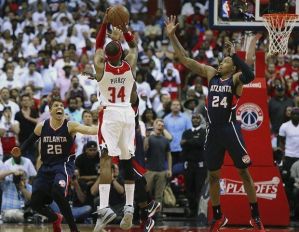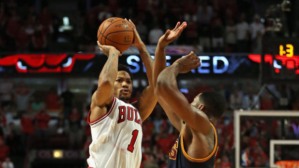If the first round of the 2015 NBA PLayoffs was all about dealing with the weight of expectation, for me, the Conference Semi-Finals were about pressure moments. During this round we saw several examples of individual players stepping up to the mark and delivering in the face of extreme pressure.
Michael Jordan did it to win his 6th NBA Championship. Damian Lillard won a series with one in last the 2014 playoffs. Robert Horry made it an art-form during his career. I’m talking, of course, about the game-winner, the buzzer-beater, the last second shot.
The last second shot.
In the 2015 Conference Semi-Finals, we saw no less than four game winning shots and Paul Pierce was a tenth of a second from hitting a huge shot in Game 6 of the Wizard’s series against the Hawks. Everyone who’s ever played sports has imagined themselves winning the game for their team in the dying moments, rising up as the clock winds down to sink a last second game-winner.
In other sports too, a footballer might think about soaring above the defender to head home a winner in the 93rd minute, or an athlete might dream of coming from behind down the home straight to beat their opponent on the line.
We’ve all imagined it, but when it comes down to it, how many of us actively seek out that pressure, and take those challenges head on? Are you the type of athlete who will demand to be front and centre in that situation?
In Game 4 of the Cavs/Bulls series, Lebron James made a series of mistakes in the final quarter, but with the game tied and only 1.5 seconds left, he changed the play that coach David Blatt had drawn up (a play which had James inbounding the ball), got open and hit a jumpshot to win the game. Now I’m not advocating changing plays that your coach draws up, but this was a great example of a player willing to put his own neck on the line, to make a play for his team.
Achieving Success or Avoiding Failure
There are a couple of theories of motivation that might be important in explaining why some people seek out challenges (like taking last second shots in basketball games) and why some people might prefer to sit back and let someone else to take the shot. Let’s ignore skill level for the moment (obviously if you’re a terrible shooter, you might have reasons to want someone else to take the shot!) and focus purely on behaviour.
Need Achievement Theory¹ suggests, quite simply, that everyone wants to achieve success and everyone wants to avoid failure. But the balance of these two motives isn’t the same in everyone. Pretty obviously those with high motivation to achieve success and low motivation to avoid failure, tend to be high achievers. Athletes who are more concerned with avoiding failure than achieving success are much less likely to be high achievers.
There are also situational factors that might play a role here. According to Need Achievement Theory, we also consider the probability of success in any situation and the value of success. If you’re facing an easy opponent, the probability of being successful is high, but the value of success is quite low.
For an extremely difficult challenge, the opposite is true (low probability/high value). So for optimal challenges (difficult but attainable), high achievers tend to step up because they see the potential for success, whereas low achievers shy away because they see the potential for criticism if they fail.
Is it all about personality?
I don’t think it would be too controversial to suggest that Paul Pierce, Derrick Rose, and LeBron James are high achievers. There are several other theories of motivation that contribute to our understanding of achievement behaviour that I won’t go into in this post, but essentially, high achievers are those who seek out challenges, perform well when being evaluated (e.g., in front of an audience), believe that success is a result of stable and controllable factors (rather than luck), tend to focus more on task than outcome goals, and focus on the pride of success rather than the shame of failure. But knowing this, it’s certainly possible to work with athletes to help them develop these tendencies.
Developing a last-shot mentality
- 1. Understand your own motivation. Or if you’re a coach reading this, understand that your athletes all have different motivations. Research suggests that at the age of around 4 or 5, children move on from being completely self-focused and start comparing themselves to those around them. As people grow older still, some develop more of an awareness of when comparison with others is useful and when it isn’t, but that can happen at any age, or not at all. Knowing yourself/your athletes is the first step to developing a last-shot mentality.
- 2. Think about your goals carefully. Are your goals about outcomes (winning) or about how you’re going to win? It’s easy to focus on winning as a goal, but make sure that the process or task goals are emphasised. Read this post on why goal setting often fails for more tips.
- 3. Think about the feedback you give your athletes/yourself. When you succeed, make sure you acknowledge the hard work, effort, and skill that has contributed to that success. When things go wrong, make sure feedback is instructional and acknowledge outside influences that might be a cause. It’s really important to be realistic here though. There’s no use blaming failure on those external, uncontrollable factors, if it really was down to lack of effort!
- 4. Do you approach challenges, or do you pick tasks that are easy? Make sure you train under conditions that are difficult, but also where success is possible. Setting up tasks that are too easy might give you/your athletes opportunities to achieve success, but there’s little, if any, value attached to that success. Similarly, it’s easy to reduce effort or give up on tasks that are obviously too difficult. Find the balance.
So there you have it. Are you motivated to achieve success or are you more concerned with avoiding failure? What subtle changes could you make to the ways you think about training and competition, about success and failure, in order to develop a last-shot mentality? Oh and remember, it helps if you can actually shoot well enough to back it up.
References
¹Atkinson, J.W. (1974). The mainstream of achievement-oriented activity. In J.W. Atkinson & J.O. Raynor (Eds.), Motivation and achievement (pp.13-41). New York: Halstead.




2 comments for “The Last Second Shot: Psychology of the 2015 NBA Playoffs – Round 2”